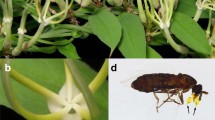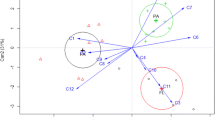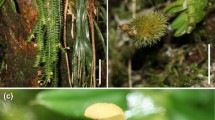Abstract
The obligate pollination mutualism between Yucca and yucca moths is a classical example of coevolution. Oviposition and active pollination by female yucca moths occur at night when Yucca flowers are open and strongly scented. Thus, floral volatiles have been suggested as key sensory signals attracting yucca moths to their host plants, but no bioactive compounds have yet been identified. In this study, we showed that both sexes of the pollinator moth Tegeticula yuccasella are attracted to the floral scent of the host Yucca filamentosa. Chemical analysis of the floral headspace from six Yucca species in sections Chaenocarpa and Sarcocarpa revealed a set of novel tetranorsesquiterpenoids putatively derived from (E)-4,8-dimethyl-1,3,7-nonatriene. Their structure elucidation was accomplished by NMR analysis of the crude floral scent sample of Yucca treculeana along with GC/MS analysis and confirmed by total synthesis. Since all these volatiles are included in the floral scent of Y. filamentosa, which has been an important model species for understanding the pollination mutualism, we name these compounds filamentolide, filamentol, filamental, and filamentone. Several of these compounds elicited antennal responses in pollinating (Tegeticula) and non-pollinating (Prodoxus) moth species upon stimulation in electrophysiological recordings. In addition, synthetic (Z)-filamentolide attracted significant numbers of both sexes of two associated Prodoxus species in a field trapping experiment. Highly specialized insect-plant interactions, such as obligate pollination mutualisms, are predicted to be maintained through “private channels” dictated by specific compounds. The identification of novel bioactive tetranorsesquiterpenoids is a first step in testing such a hypothesis in the Yucca-yucca moth interaction.








Similar content being viewed by others

Data Availability
Voucher moth specimens have been deposited at the Cornell University Insect Collection (accessions CUIC000002359-CUIC000002431).
Code Availability
not applicable.
References
Althoff DM, Segraves KA, Smith CI, Leebens-Mack J, Pellmyr O (2012) Geographic isolation trumps coevolution as a driver of yucca and yucca moth diversification. Mol Phylogenet Evol 62:898–906
Althoff DM, Fox KA, Frieden T (2014) The role of ecological availability and host plant characteristics in determining host use by the bogus yucca moth Prodoxus decipiens. Ecol Entomol 39:620–626
Boland W, Gäbler A, Gilbert M, Feng Z (1998) Biosynthesis of C11 and C16 homoterpenes in higher plants; stereochemistry of the C-C-bond cleavage reaction. Tetrahedron 54:14725–14736
Borges RM, Bessière JM, Hossaert-Mckey M (2008) The chemical ecology of seed dispersal in monoecious and dioecious figs. Funct Ecol 22:484–493
Burkhardt F, Smith S (Eds) (1994) Calendar of the correspondence of Charles Darwin, 1809–1882, with Supplement. Cambridge University Press, Cambridge
Davis DR (1967) A revision of the moths of the subfamily Prodoxinae (Lepidoptera: Incurvariidae). United States Natural History Museum, Bulletin 255:1–170
Dess DB, Martin JC (1983) Readily accessible 12-I-5 oxidant for the conversion of primary and secondary alcohols to aldehydes and ketones. J Org Chem 48:4155–4156
Dess DB, Martin JC (1991) A useful 12-I-5 triacetoxyperiodinane (the Dess-Martin periodinane) for the selective oxidation of primary or secondary alcohols and a variety of related 12-I-5 species. J Am Chem Soc 113:7277–7287
Dufaÿ M, Anstett MC (2003) Conflicts between plants and pollinators that reproduce within inflorescences: evolutionary variations on a theme. Oikos 100:3–14
Dunkelblum E, Tan SH, Silk PJ (1985) Double-bond location in monounsaturated fatty acids by dimethyl disulfide derivatization and mass spectrometry: application to analysis of fatty acids in pheromone glands of four Lepidoptera. J Chem Ecol 11:265–277
Engelmann G (1872) The flower of yucca and its fertilization. Bull Torrey Bot Club 3:33
Fleming TH, Holland JN (1998) The evolution of obligate pollination mutualisms: senita cactus and senita moth. Oecologia 114:368–375
Francis GW, Veland K (1981) Alkylthiolation for the determination of double-bond positions in linear alkenes. J Chromatogr A 219:379–384
Gäbler A, Boland W, Preiss U, Simon H (1991) Stereochemical studies on homoterpene biosynthesis in higher plants: mechanistic, phylogenetic, and ecological aspects. Helv Chim Acta 74:1773–1789
Godsoe W, Yoder JB, Smith CI, Pellmyr O (2008) Coevolution and divergence in the Joshua tree/yucca moth mutualism. Am Nat 171:816–823
Hossaert-McKey M, Soler C, Schatz B, Proffit M (2010) Floral scents: their roles in nursery pollination mutualisms. Chemoecology 20:75–88
Huth CJ, Pellmyr O (1999) Yucca moth oviposition and pollination behavior is affected by past flower visitors: evidence for a host-marking pheromone. Oecologia 119:593–599
Kaiser R (1994) Trapping, investigation and reconstitution of flower scents. In: Müller PM, Lamparsky D (eds) Perfumes: art, science & technology. Elsevier Applied Science, London, New York, Chapter 7, 213–250
Kawakita A (2010) Evolution of obligate pollination mutualism in the tribe Phyllantheae (Phyllanthaceae). Plant Spec Biol 25:3–19
Kramp W, Bohlmann F (1986) Synthese natürlich vorkommender geranylgeraniol-Derivate. Liebigs Ann Chem 2:226–233
Larson GL, Betancourt de Perez RM (1985) A two-step preparation of α-alkylidene γ-lactones from γ-lactones: A synthesis of (±)-ancepsenolide. J Org Chem 50:5257–5260
Marr DL, Pellmyr O (2003) Effect of pollinator-inflicted ovule damage on floral abscission in the yucca-yucca moth mutualism: the role of mechanical and chemical factors. Oecologia 136:236–243
Maryanoff BE, Reitz AB (1989) The Wittig olefination reaction and modifications involving selected synthetic aspects phosphoryl-stabilized carbanions. Stereochemistry, mechanism, and selected synthetic aspects. Chem Rev 89:863–927
Milla E (2019) Evolution and ecology of the Australian Heliozelidae (Adeloidea, Lepidoptera). Ph.D. dissertation. University of Melbourne, Melbourne
Nunes CEP, Maruyama PK, Azevedo-Silva M, Sazima M (2018) Parasitoids turn herbivores into mutualists in a nursery system involving active pollination. Curr Biol 28:980–986
Paré PW, Tumlinson JH (1999) Plant volatiles as a defense against insect herbivores. Plant Physiol 121:325–332
Patt JM, Meikle WG, Mafra-Neto A, Sétamou M, Mangan R, Yang C, Malik N, Adamczyk JJ (2011) Multimodal cues drive host-plant assessment in Asian citrus psyllid (Diaphorina citri). Environ Entomol 40:1494–1502
Peakall R, Ebert D, Poldy J, Barrow RA, Francke W, Bower CC, Schiestl FP (2010) Pollinator specificity, floral odour chemistry and the phylogeny of Australian sexually deceptive Chiloglottis orchids: implications for pollinator-driven speciation. New Phytol 188:437–450
Pellmyr O (1999) Systematic revision of the yucca moths in the Tegeticula yuccasella complex (Lepidoptera: Prodoxidae) north of Mexico. Syst Entomol 24:243–271
Pellmyr O, Balcázar-Lara M (2000) Systematics of the yucca moth genus Parategeticula (Lepidoptera: Prodoxidae), with description of three Mexican species. Ann Entomol Soc Am 93:432–439
Pellmyr O, Huth CJ (1994) Evolutionary stability of mutualism between yuccas and yucca moths. Nature 372:257–260
Pellmyr O, Krenn HW (2002) Origin of a complex key innovation in an obligate insect-plant mutualism. Proc Natl Acad Sci USA 99:5498–5502
Pellmyr O, Leebens-Mack J (1999) Forty million years of mutualism: evidence for Eocene origin of the yucca-yucca moth association. Proc Natl Acad Sci USA 96:9178–9183
Pellmyr O, Segraves KA (2003) Pollinator divergence within an obligate mutualism: two yucca moth species (Lepidoptera; Prodoxidae: Tegeticula) on the Joshua tree (Yucca brevifolia; Agavaceae). Ann Entomol Soc Am 96:716–722
Pellmyr O, Balcázar-Lara M, Althoff DM, Segraves KA, Leebens-Mack J (2006) Phylogeny and life history evolution of Prodoxus yucca moths (Lepidoptera: Prodoxidae). Syst Entomol 31:1–12
Pellmyr O, Balcázar-Lara M, Segraves KA, Althoff DM, Littlefield RJ (2008) Phylogeny of the pollinating yucca moths, with revision of Mexican species (Tegeticula and Parategeticula; Lepidoptera, Prodoxidae). Zool J Linn Soc 152:297–314
Pellmyr O, Segraves KA, Althoff DM, Balcázar-Lara M, Leebens-Mack J (2007) The phylogeny of yuccas. Mol Phylogenet Evol 43:493–501
Pellmyr O, Kjellberg F, Herre EA, Kawakita A, Hembry DH, Holland JN, Terrazas T, Clement W, Segraves KA, Althoff DM (2020) Active pollination drives selection for reduced pollen-ovule ratios. Am J Bot 107:164–170
Poulter CD, Wiggins PL, Plummer TL (1981) Synthesis of fluorinated analogs of geraniol. J Org Chem 46:1532–1538
Raguso RA (2008) Wake up and smell the roses: the ecology and evolution of floral scent. Annu Rev Ecol Evol S 39:549–569
Rentsch JD, Leebens-Mack J (2012) Homoploid hybrid origin of Yucca gloriosa: intersectional hybrid speciation in Yucca (Agavoideae, Asparagaceae). Ecol Evol 2:2213–2222
de la Rosa-Conroy L, Arteaga MC, Bullock SH, Eguiarte LE, Bello-Bedoy R (2019) Population variation in the intensity of fruit infestation and pre-dispersal seed predation in Yucca schidigera (Asparagaceae) by its obligate pollinator. Plant Ecol 220:711–720
Schiestl FP, Peakall R, Mant JG, Ibarra F, Schulz C, Franke S, Francke W (2003) The chemistry of sexual deception in an orchid-wasp pollination system. Science 302:437–438
Schiestl FP, Peakall R (2005) Two orchids attract different pollinators with the same floral odour compound: ecological and evolutionary implications. Funct Ecol 19:674–680
Schultz K, Kaiser R, Knudsen JT (1999) Cyclanthone and derivatives, new natural products in the flower scent of Cyclanthus bipartitus Poit. Flavour Fragrance J 14:185–190
Segraves KA (2003) Understanding stability in mutualisms: do extrinsic factors balance the yucca-yucca moth interaction? Ecology 84:2943–2951
Smith CI, Pellmyr O, Althoff DM, Balcázar-Lara M, Leebens-Mack J, Segraves KA (2008) Pattern and timing of diversification in Yucca (Agavaceae): specialized pollination does not escalate rates of diversification. Proc R Soc Lond Ser B Biol Sci 275:249–258
Smith CI, McKain MR, Guimond A, Flatz R (2021) Genome-scale data resolves the timing of divergence in Joshua trees. Am J Bot 108:1–17
Soler CCL, Proffit M, Chen C, Hossaert-McKey M (2010) Private channels in plant–pollinator mutualisms. Plant Signal Behav 5:893–895
Stamm P, Etl F, Maia ACD, Dötterl S, Schulz S (2021) Synthesis, absolute configurations, and biological activities of floral scent compounds from night-blooming Araceae. J Org Chem 86:5245–5254
Svensson GP, Hickman MOJ, Bartram S, Boland W, Pellmyr O, Raguso RA (2005) Chemistry and geographic variation of floral scent in Yucca filamentosa (Agavaceae). Am J Bot 92:1624–1631
Svensson GP, Pellmyr O, Raguso RA (2006) Strong conservation of floral scent composition in two allopatric yuccas. J Chem Ecol 32:2657–2665
Svensson GP, Okamoto T, Kawakita A, Goto R, Kato M (2010) Chemical ecology of obligate pollination mutualisms: testing the “private channel” hypothesis in the Breynia-Epicephala association. New Phytol 186:995–1004
Svensson GP, Pellmyr O, Raguso RA (2011) Pollinator attraction to volatiles from virgin and pollinated host flowers in a yucca/moth obligate mutualism. Oikos 120:1577–1583
Svensson GP, Raguso RA, Flatz R, Smith CI (2016) Floral scent of Joshua trees (Yucca brevifolia sensu lato): divergence in scent profiles between species but breakdown of signal integrity in a narrow hybrid zone. Am J Bot 103:1793–1802
Trelease W (1893) Further studies of yuccas and their pollination. Missouri Bot Gard Annual Rep 4:181–226
Tröger A, Svensson GP, Althoff DM, Segraves KA, Raguso RA, Francke W (2019) The pattern of straight chain hydrocarbons released by Yucca flowers (Asparagaceae). J Chem Ecol 45:46–49
Twele R (2009) Identifizierung und Synthese verhaltensmodifizierender Signalstoffe aus Insekten und Pflanzen. Ph.D. dissertation. University of Hamburg, Hamburg
Vet LE, Lenteren JV, Heymans M, Meelis E (1983) An airflow olfactometer for measuring olfactory responses of hymenopterous parasitoids and other small insects. Physiol Entomol 8:97–106
Wang CP, Kameoka H (1977) The constituents of the essential oil from the flower of Yucca gloriosa L. J Agric Chem Soc Jap 51:649–653
Wang CP, Kameoka H (1978) The constituents of the essential oil from the flower of Yucca filamentosa L. J Agric Chem Soc Jap 52:607–610
Wang CP, Kameoka H (1980) Constituents of the essential oil of the flower of Yucca recurvifolia Salisb. J Agric Chem Soc Jap 54:331–336
Wegener R, Schulz S (2002) Identification and synthesis of homoterpenoids emitted from elm leaves after elicitation by beetle eggs. Tetrahedron 58:315–319
Weiblen GD (2002) How to be a fig wasp. Ann Rev Entomol 47:299–330
Whitehead MR, Peakall R (2014) Pollinator specificity drives strong prepollination reproductive isolation in sympatric sexually deceptive orchids. Evolution 68:1561–1575
Wittig G, Geissler G (1953) Zur Reaktionsweise des Pentaphenyl-phosphors und einiger Derivate. Liebigs Ann Chem 580:44–57
Acknowledgements
GPS was funded by the Crafoord Foundation, the Swedish Royal Academy of Sciences, and Wenner-Gren Foundations. KAS and DMA were funded by NSF DEB 1556568 and 1655544. We acknowledge the Archbold Biological Station for providing access to field sites and for permission to work with Tegeticula pupae. Special thanks to Christopher Smith (Willamette University) for providing key headspace samples from Yucca schidigera. We thank Wilhelm Boland (Max-Planck-Institute, Jena), Jim Leebens-Mack (University of Georgia), Mike Walla (University of South Carolina), and especially Olle Pellmyr (deceased) for the initial discussions that launched this project.
Funding
GPS was funded by the Crafoord Foundation, the Swedish Royal Academy of Sciences, and Wenner-Gren Foundations. KAS and DMA were funded by NSF DEB 1556568 and 1655544.
Author information
Authors and Affiliations
Contributions
Headspace samples were collected by GPS, KAS, DMA, JMP, and RAR. Field trapping, behavioral and electrophysiological assays were performed by GPS, JMP, and RAR. Chemical analyses, organic synthesis, and structural determinations were accomplished by AT, H-MG, RT, SB, PHGZ, SvR, and WF. The manuscript was written by AT, GPS, SvR, and RAR and was edited by all authors.
Corresponding author
Ethics declarations
Conflicts of Interest/Competing Interests
The authors disclose no competing interests.
Additional information
Wittko Francke, Deceased, 27th of December 2020
Supplementary Information
Synthesis of novel compounds is described in the electronic supplementary material, see link below.
Rights and permissions
About this article
Cite this article
Tröger, A., Svensson, G.P., Galbrecht, HM. et al. Tetranorsesquiterpenoids as Attractants of Yucca Moths to Yucca Flowers. J Chem Ecol 47, 1025–1041 (2021). https://doi.org/10.1007/s10886-021-01308-4
Received:
Revised:
Accepted:
Published:
Issue Date:
DOI: https://doi.org/10.1007/s10886-021-01308-4



